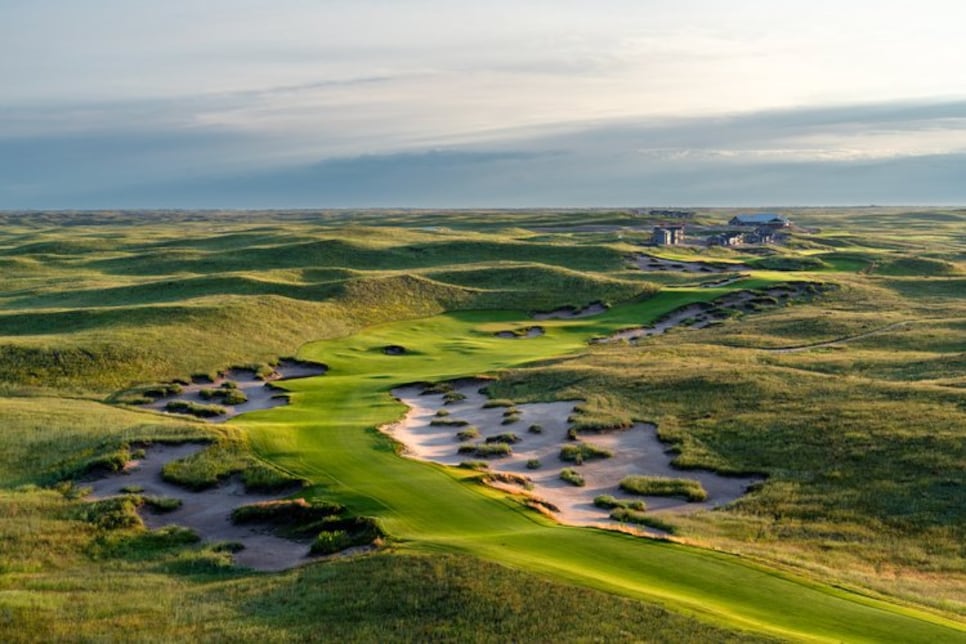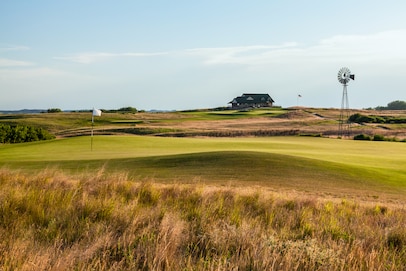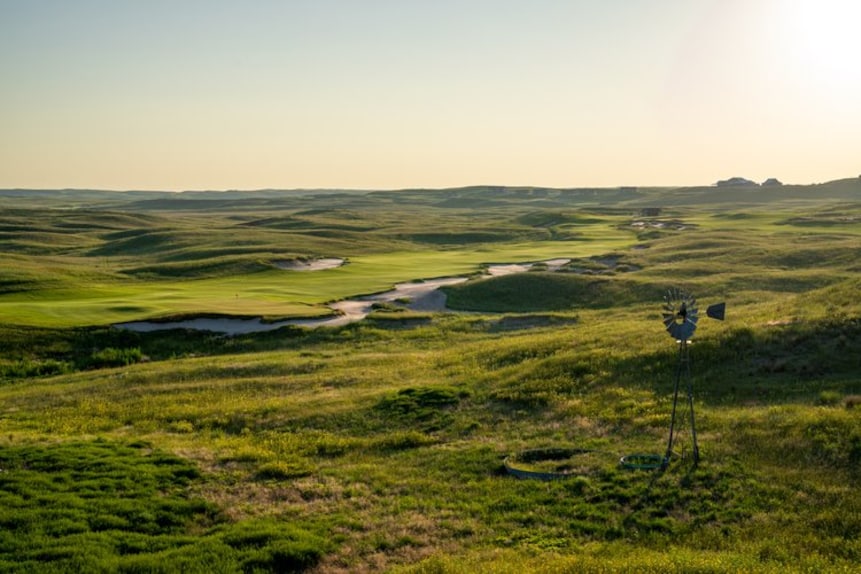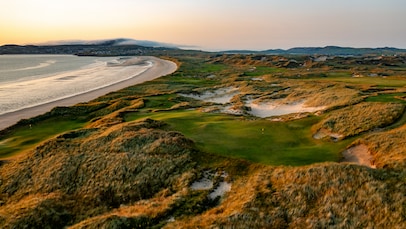GrayBull is the newest course in Nebraska’s Sandhills. How does it stack up against its neighbors? – Australian Golf Digest

- by Admin
- October 6, 2024

If you’ve never driven through the Sandhills region of Nebraska, you haven’t seen one of the world’s most extraordinary golf landscapes.
It’s understandable if you haven’t. There’s little reason for anyone who isn’t a rancher or a golf pilgrim to delve into the 20,000-square miles of heaving, grass-covered dunes that cover the northwest and north-central part of the state, most of which has only been observed by cattle, cowboys and birds. The dunes are staggering in their size and relentlessness. Many rise 100 feet or more, and that’s just what can be witnessed from the numbingly straight perimeters of county roads that bracket the land every 30 or 60 miles. What lies beyond is almost unfathomable.
Golfers—at least those outside Nebraska—knew next to nothing of this territory until 1995 when Sand Hills Golf Club opened 12 miles south of the town of Mullen as the crow, or Sandhills crane, flies. To get there, golfers had to first navigate to North Platte, then cut 60 miles north through the dunes, turning the last three into the belly of the beast toward the small clubhouse. The extended journey was unlike anything any golfer had to previously undertake, and the sandy confines revealed a kind of golf also unlike anything seen before.
Given the vastness and infinite potential for landforms, there’s an obvious desire to build more courses in the region. Yet since Sand Hills, ranked eighth in Golf Digest’s America’s 100 Greatest Courses, just six others have opened, seven if you count Wild Horse, a public course east of North Platte that’s right on the edge. So rare are they, it’s major news when a new one is born.
GrayBull Club is the newest addition. Opened in July, the course is also the latest addition to the Dormie Network, the private club network founded by Nebraska natives Tom and Zach Peed that offers national members the use of seven different affiliate courses, including Victoria National in Indiana (ranked 53rd) and Ballyhack in Virginia (No. 191). The Peeds and architect David McLay Kidd looked at several sites in the vicinity of North Platte and settled on nearly 2,000 acres of mostly gently swelling dunes a 35-minute drive to the northwest.
Evan Schiller
More from Golf Digest  Golf Digest Logo 10 courses that give you the best bang for your buck, ranked by our course experts
Golf Digest Logo 10 courses that give you the best bang for your buck, ranked by our course experts
The GrayBull parcel resembles other Sandhills courses in that there were natural golf holes to be found everywhere, in all directions. The riddle hinges on identifying 18 of the best that can be seamlessly connected. When Bill Coore and Ben Crenshaw built Sand Hills, they mapped out 130 potential holes. This was Kidd’s experience, too: GrayBull had holes galore and room for multiple courses, but the owners told him they needed just one. That put the entire site in play rather than smaller sections. The answer to this riddle was to use as much of the property as one golf course could, and the routing makes a profound, clockwise journey though the wilds without pause, gobbling up space as it slithers into the valleys and through natural gaps in the dunes.
Where the course differs is in some of the design details. The bunkers at other Sandhills courses (Dismal River, the Prairie Club and CapRock Ranch) are generally simplified to resemble the blowouts that naturally occur in the area’s high winds. GrayBull’s bunkers were built with more intention, many of them deliberately crafted waste areas with tufted islands of fescue. The way the holes are strung together also gives the course a more polished appearance than its peers. The majority of Dormie members ride in carts, so to avoid having to build paths, strips of durable turf were extended from the putting surfaces, some of Kidd’s most exaggerated, directly onto the tees creating unbroken ribbons of green rather than holes that sit within pockets. You can walk GrayBull (it’s very walkable) and never step foot on native grass.

Evan Schiller
The golf lives up to expectations, elevated by an outstanding repertoire of par 4s. There are bruisers like the 459-yard ninth, where a large bunker hides much of the broad fairway on the left, forcing the eye to the right (obfuscation is a recurring theme) and the 472-yard 18th. The fifth and 16th are potentially reachable in the right winds if golfers can sail drives across no-man’s-lands of fescue and sand, and the swerving sixth is a play on an Alps hole, with the amphitheater-like green tucked behind a dune requiring a semi-blind approach. The variety of looks and orientations require tactical shifts on each of these holes.
The same can’t be said for the par 3s. All four play over deep caverns of sand to partially obscured greens. There’s no choice but to hoist the ball into the usually severe winds. What’s missing is a change-up look or two, and the chance to play the ball down on the firm, feeding ground, something akin to Kidd’s par-3 fourth at Gamble Sands or his third at Mammoth Dunes.
The infinite variety of the land demands a variety of strategies and presentations to match it, and GrayBull ultimately delivers. It’s a confident and seductively designed course that delivers the dopamine hit the Sandhills promise while being just enough its own thing. The question to begin pondering now is, how much more golf gold is there to extract from those hills?
 Evan Schiller false GrayBull Golf Club Maxwell, NE Architect David McLay Kidd has seen both ends of the golf site spectrum, from the incomparable ocean setting of the original Bandon Dunes course and the pine dunes of Sand Valley, all the way to lifeless land like the potato farm he inherited for St. Andrew’s Castle Course in his native Scotland. He’s not likely to get a better one than GrayBull, the course he built for the Dormie Network in the Sand Hills of Nebraska. Located about 30 minutes northeast of North Platte, just north of I-80, the 1,800-acre site provided the potential for dozens if not hundreds of different golf holes, though the owners instructed Kidd to just build 18 of them and not to worry about leaving room for a second 18—or nine, or a short course—at a future date. Thus the routing takes the long road around the site, moving in a big clockwise flow with gentle cascading movements and only a few switchbacks. There was a section of steeper dunes in the center of the property that were attractive, but they were essentially too severe and Kidd couldn’t find a way to get in and out of them without having to make big cuts to the land, something you shouldn’t have to do in the Sand Hills. The fairways are larger than they appear but are obscured by angles around the dunes and elevated bunkers, and the greens are a continuing evolution of those at Gamble Sands and Mammoth Dunes, getting progressively more contoured at each course. The strength of the design is the par 4s presented in a rich variety of lengths and orientations (the drivable fifth and 16th—in certain winds—are standouts, as is the 13th where the fairway kicks drives left into a hollow unless they challenge a large bunker on the right), adding up to a stellar addition to this vast and most interesting of golf landscapes. Explore our full review More From Golf Digest
Evan Schiller false GrayBull Golf Club Maxwell, NE Architect David McLay Kidd has seen both ends of the golf site spectrum, from the incomparable ocean setting of the original Bandon Dunes course and the pine dunes of Sand Valley, all the way to lifeless land like the potato farm he inherited for St. Andrew’s Castle Course in his native Scotland. He’s not likely to get a better one than GrayBull, the course he built for the Dormie Network in the Sand Hills of Nebraska. Located about 30 minutes northeast of North Platte, just north of I-80, the 1,800-acre site provided the potential for dozens if not hundreds of different golf holes, though the owners instructed Kidd to just build 18 of them and not to worry about leaving room for a second 18—or nine, or a short course—at a future date. Thus the routing takes the long road around the site, moving in a big clockwise flow with gentle cascading movements and only a few switchbacks. There was a section of steeper dunes in the center of the property that were attractive, but they were essentially too severe and Kidd couldn’t find a way to get in and out of them without having to make big cuts to the land, something you shouldn’t have to do in the Sand Hills. The fairways are larger than they appear but are obscured by angles around the dunes and elevated bunkers, and the greens are a continuing evolution of those at Gamble Sands and Mammoth Dunes, getting progressively more contoured at each course. The strength of the design is the par 4s presented in a rich variety of lengths and orientations (the drivable fifth and 16th—in certain winds—are standouts, as is the 13th where the fairway kicks drives left into a hollow unless they challenge a large bunker on the right), adding up to a stellar addition to this vast and most interesting of golf landscapes. Explore our full review More From Golf Digest  Golf Digest Logo The best golf courses in Europe
Golf Digest Logo The best golf courses in Europe  Golf Digest Logo World’s 100 Greatest Golf Courses
Golf Digest Logo World’s 100 Greatest Golf Courses  Golf Digest Logo The 13 most fun golf courses in the U.S., according to our expert
Golf Digest Logo The 13 most fun golf courses in the U.S., according to our expert
This article was originally published on golfdigest.com
The Latest News
-
December 26, 2024Injured Halep forced to pull out of Australian Open
-
December 26, 2024Rules of Golf Review: It was only a tap-in, but my opponent raked his putt into the hole. Is that legal? – Australian Golf Digest
-
December 26, 2024Simona Halep issues ‘little update’ following Australian Open setback
-
December 26, 2024Australian tennis suffers two worrying setbacks ahead of the 2025 Australian Open
-
December 26, 2024Heatwave sparks warning of potentially devastating wildfires in Australian state





